1 W High Performance LED-Array Based Optical Wireless Power Transmission System for IoT Terminals
Abstract
:1. Introduction
2. Saturation Output of LED-OWPT in Small Size Receivers
2.1. Effect Factors in LED-OWPT Collimation Schemes
2.2. Numerical Analysis of LED-OWPT Saturated Output
- Optical simulation explores the relationship between the single LED irradiation power and the lens parameters.
- The regression equations are fitted to the obtained results, and then the equations are extended to the case of n × n array LEDs for calculating the maximum value.
- The results are verified with simulations under the specific setup conditions.
- Imaging lens: 100 × 100 mm2 aperture; 1000 mm focal length.
- GaAs solar cell: 50 × 50 mm2 size, 1000 mm away from the imaging lens.
3. Experimental Demonstration of High Output LED-OWPT
3.1. Design and Experiment Setup of 3 × 3 Array LED-OWPT
3.2. Results and Analysis
3.3. Thermal Features of High-Power LED-OWPT
4. Discussion of Electricity Output and Lens Aperture
5. Conclusions
Author Contributions
Funding
Institutional Review Board Statement
Informed Consent Statement
Data Availability Statement
Conflicts of Interest
References
- Miyamoto, T. Optical wireless power transmission using VCSELs. In Semiconductor Lasers and Laser Dynamics VIII; SPIE Photonics Europe: Strasbourg, France, 2018; Volume 10682. [Google Scholar]
- Zhao, M.; Miyamoto, T. High output and high efficiency handy-sized LED-array based optical wireless power transmission system using Fresnel lenses. In Proceedings of the 26th Microoptics Conference (MOC2021), Hamamatsu, Japan, 27–29 September 2021. [Google Scholar]
- Lee, I.; Lee, K. The Internet of Things (IoT): Applications, Investments, and Challenges for Enterprises. Bus. Horiz. 2015, 58, 431–440. [Google Scholar] [CrossRef]
- Putra, A.W.S.; Kato, H.; Adinanta, H.; Maruyama, T. Optical wireless power transmission to moving object using galvano mirror. In Proceedings of the Free-Space Laser Communications XXXII, San Francisco, CA, USA, 3–4 February 2020; Volume 11272, pp. 314–322. [Google Scholar]
- Nguyen, D.H. Optical wireless power transfer for moving objects as A life-support technology. In Proceedings of the 2020 IEEE 2nd Global Conference on Life Sciences and Technologies, Kyoto, Japan, 10–12 March 2020. [Google Scholar]
- Fakidis, J.; Videv, S.; Kucera, S.; Claussen, H.; Haas, H. Indoor Optical Wireless Power Transfer to Small Cells at Nighttime. J. Lightwave Technol. 2016, 34, 3236–3258. [Google Scholar] [CrossRef]
- Diamantoulakis, P.D.; Karagiannidis, G.K. Simultaneous lightwave information and power transfer (SLIPT) for indoor IoT applications. In Proceedings of the IEEE Global Communications Conference, Singapore, 4–8 December 2017. [Google Scholar]
- Iyer, V.; Bayati, E.; Nandakumar, R.; Majumdar, A.; Gollakota, S. Charging a Smartphone Across a Room Using Lasers. Proc. ACM Interact. Mob. Wearable Ubiquitous Technol. 2018, 1, 1–21. [Google Scholar] [CrossRef]
- Liu, Q.; Xiong, M.; Liu, M.; Jiang, Q.; Fang, W.; Bai, Y. Charging A Smartphone Over the Air: The Resonant Beam Charging Method. arXiv 2022, arXiv:2105.13174. [Google Scholar] [CrossRef]
- Wi-Charge, the Wireless Power Company. Available online: https://www.wi-charge.com (accessed on 23 June 2022).
- IEC 60825:2022 SER. Available online: https://webstore.iec.ch/publication/62424 (accessed on 13 June 2022).
- Zhou, Y.; Miyamoto, T. 200 mW-Class LED-Based Optical Wireless Power Transmission for Compact IoT. Jpn. J. Appl. Phys. 2019, 58, SJJC04. [Google Scholar] [CrossRef]
- Zhou, Y.; Miyamoto, T. 400 mW Class High Output Power from LED-Array Optical Wireless Power Transmission System for Compact IoT. IEICE Electron. Express 2021, 18, 20200405. [Google Scholar] [CrossRef]
- Zhao, M.; Miyamoto, T. Optimization for Compact and High Output LED-Based Optical Wireless Power Transmission System. Photonics 2022, 9, 14. [Google Scholar] [CrossRef]
- Würfel, P.; Würfel, U. Physics of Solar Cells: From Basic Principles to Advanced Concepts, 3rd ed.; John Wiley & Sons: Hoboken, NJ, USA, 2016; pp. 160–172. [Google Scholar]
- Carr, W.N. Characteristics of a GaAs Spontaneous Infrared Source with 40 Percent Efficiency. IEEE Trans. Electron Devices 1965, 12, 531–535. [Google Scholar] [CrossRef]
- Zhao, M.; Miyamoto, T. Numerical analysis of maximum output in LED-based optical wireless power transmission system. In Proceedings of the 69th JSAP Spring Meeting, Online, 22–26 March 2022. [Google Scholar]
- SFH4715AS OSRAM Semiconductors. Available online: https://www.osram.com/ecat/OSLON%C2%AE%20Black%20SFH%204715AS/com/en/class_pim_web_catalog_103489/prd_pim_device_2219819/ (accessed on 13 June 2022).
- Zhou, Y.; Miyamoto, T. Tolerant Distance and Alignment Deviation Analysis of LED-Based Portable Optical Wireless Power Transmission System for Compact IoT. IEEJ Trans. Electron. Inf. Syst. 2021, 141, 1274–1280. [Google Scholar] [CrossRef]
- NTKJ Co., Ltd. Fresnel Lens Manufacturer. Available online: https://www.ntkj-japan.com (accessed on 14 June 2022).
- Tang, J.; Matsunaga, K.; Miyamoto, T. Numerical Analysis of Power Generation Characteristics in Beam Irradiation Control of Indoor OWPT System. Opt. Rev. 2020, 27, 170–176. [Google Scholar] [CrossRef]
- Bremner, S.P.; Levy, M.Y.; Honsberg, C.B. Analysis of Tandem Solar Cell Efficiencies under AM1.5G Spectrum Using a Rapid Flux Calculation Method. Prog. Photovolt. Res. Appl. 2008, 16, 225–233. [Google Scholar] [CrossRef]
- Cekon, M.; Struhala, K.; Slávik, R. Cardboard-Based Packaging Materials as Renewable Thermal Insulation of Buildings: Thermal and Life-Cycle Performance. J. Renew. Mater. 2017, 5 (Suppl. S1), S84–S93. [Google Scholar] [CrossRef]
- Plastics—Thermal Conductivity Coefficients. Available online: https://www.engineeringtoolbox.com/thermal-conductivity-plastics-d_1786.html (accessed on 13 June 2022).
- Cleary, T.G.; Quintiere, J. Flammability Characterization of Foam Plastics (NISTIR 4664); NIST Interagency/Internal Report (NISTIR); National Institute of Standards and Technology: Gaithersburg, MD, USA, 1991.
- Metals, Metallic Elements and Alloys—Thermal Conductivities. Available online: https://www.engineeringtoolbox.com/thermal-conductivity-metals-d_858.html (accessed on 13 June 2022).
- Mohammadnia, A.; Ziapour, B.M.; Ghaebi, H.; Khooban, M.H. Feasibility Assessment of Next-Generation Drones Powering by Laser-Based Wireless Power Transfer. Opt. Laser Technol. 2021, 143, 107283. [Google Scholar] [CrossRef]
- Thermal Properties: Material Thermal Properties Database. Available online: https://ncfs.ucf.edu/burn_db/Thermal_Properties/material_thermal.html (accessed on 13 June 2022).
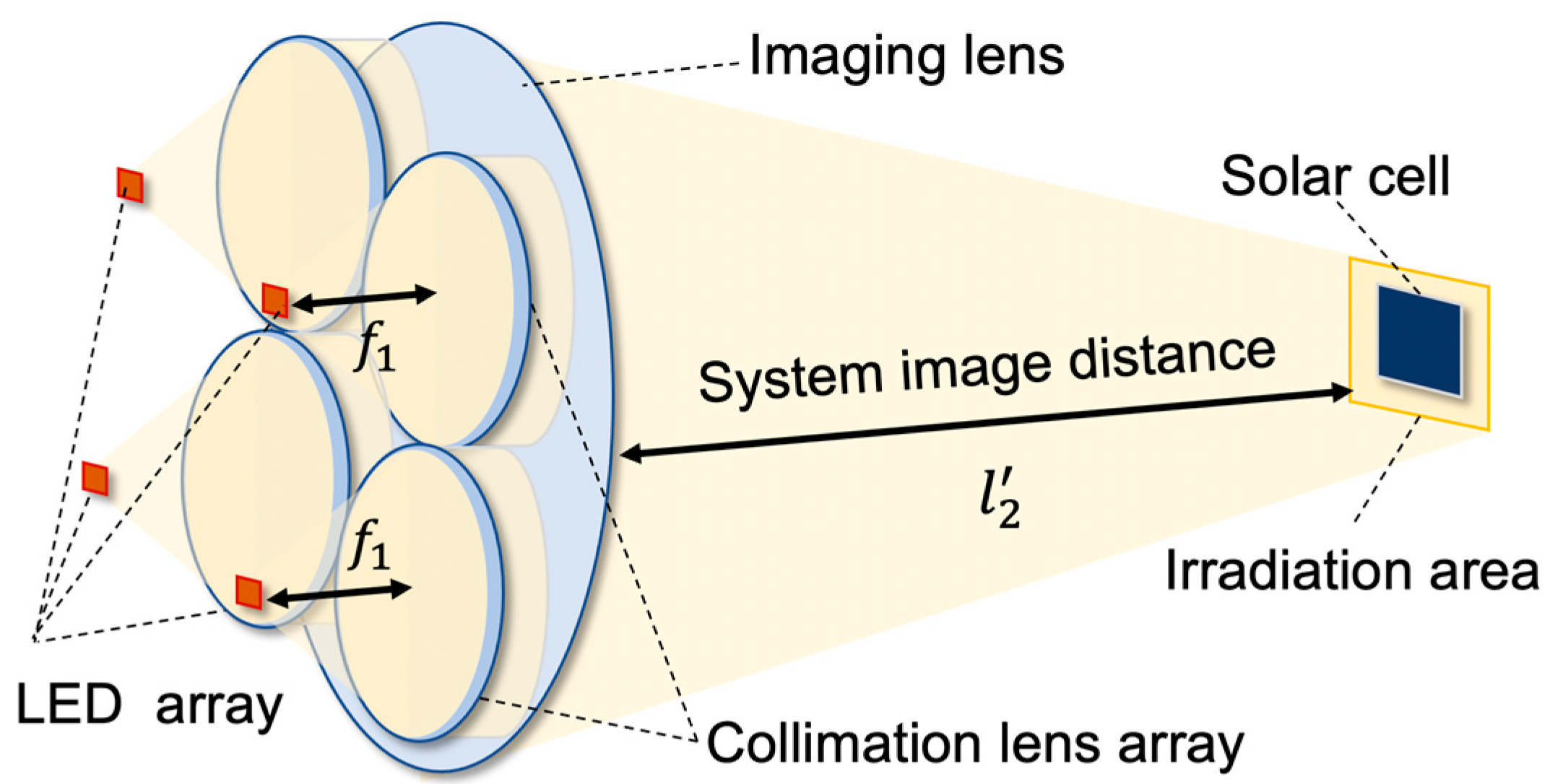
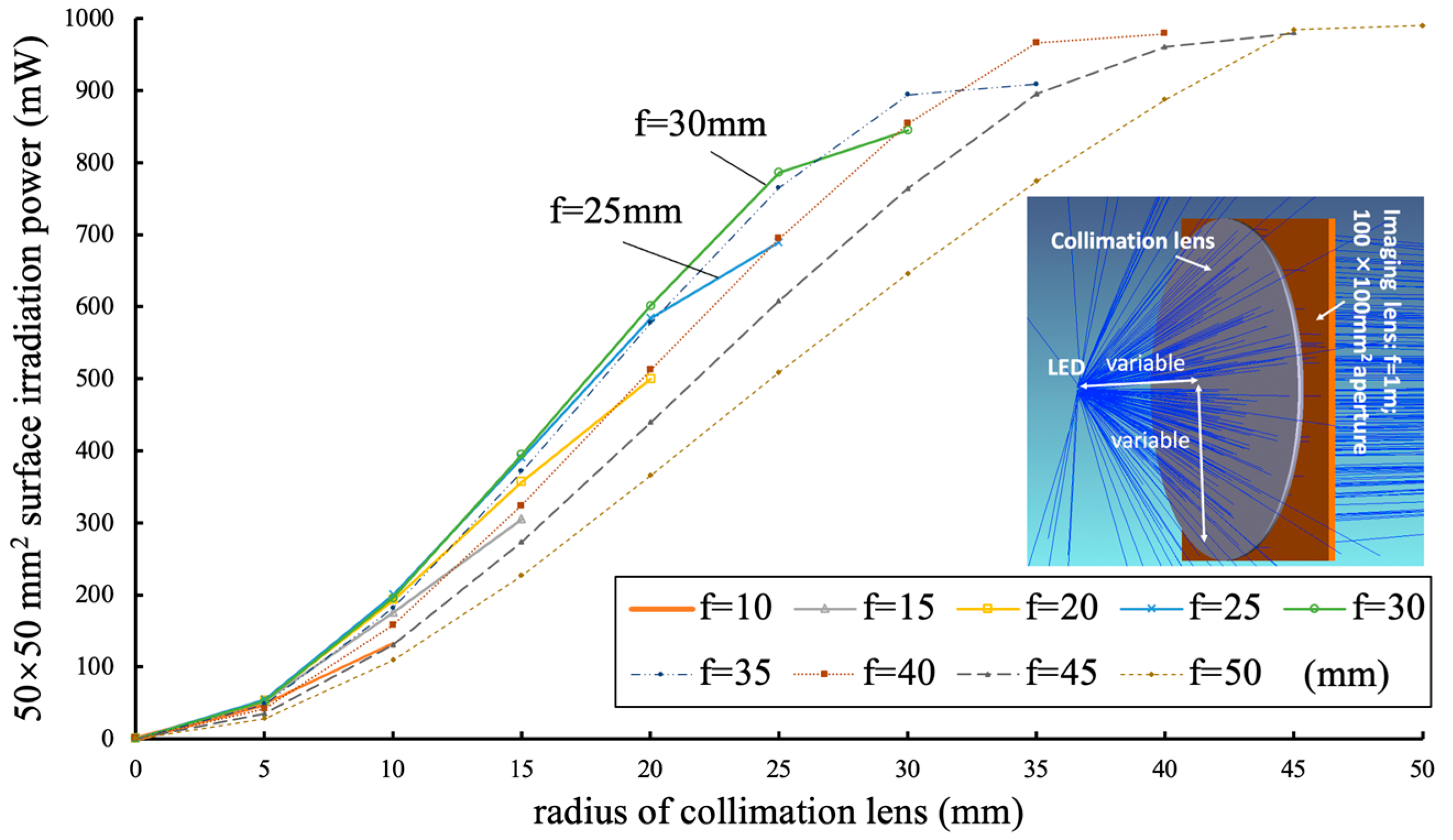
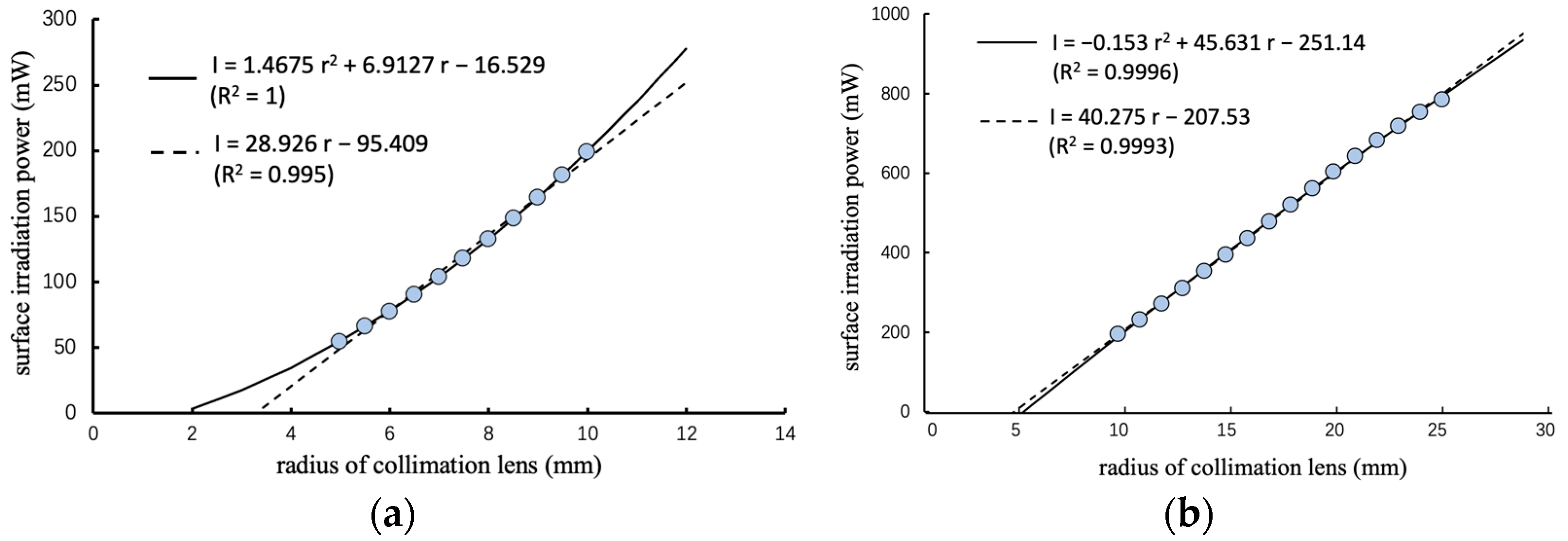


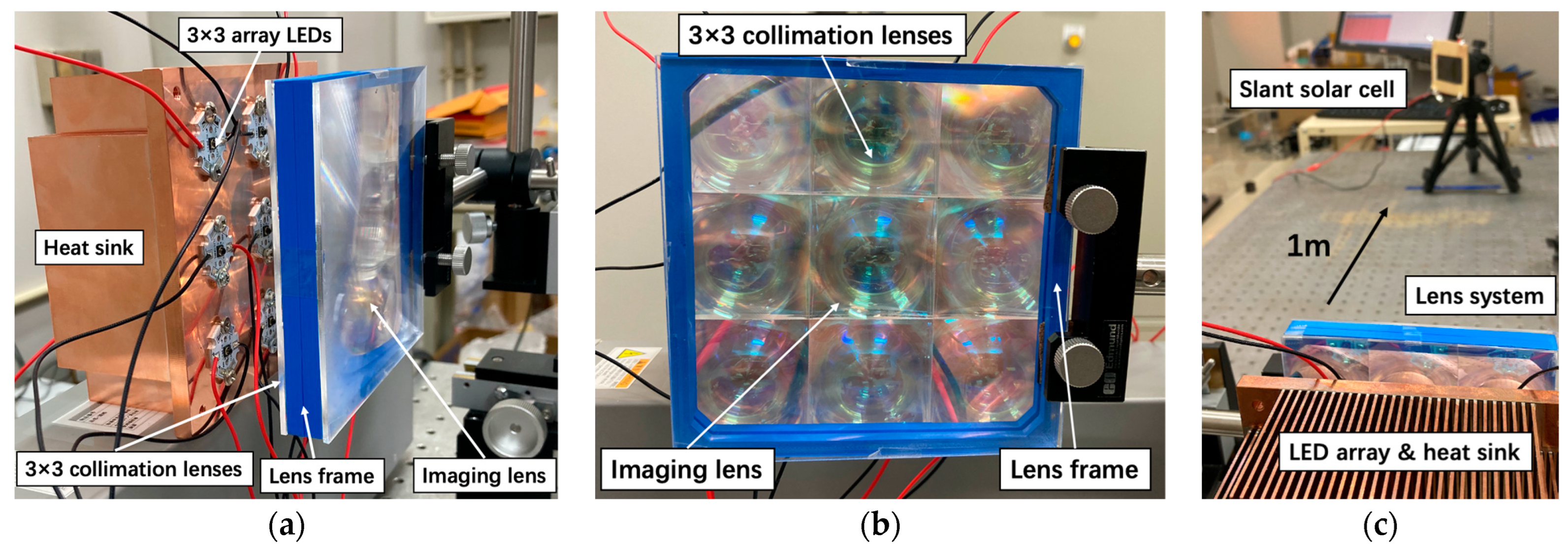
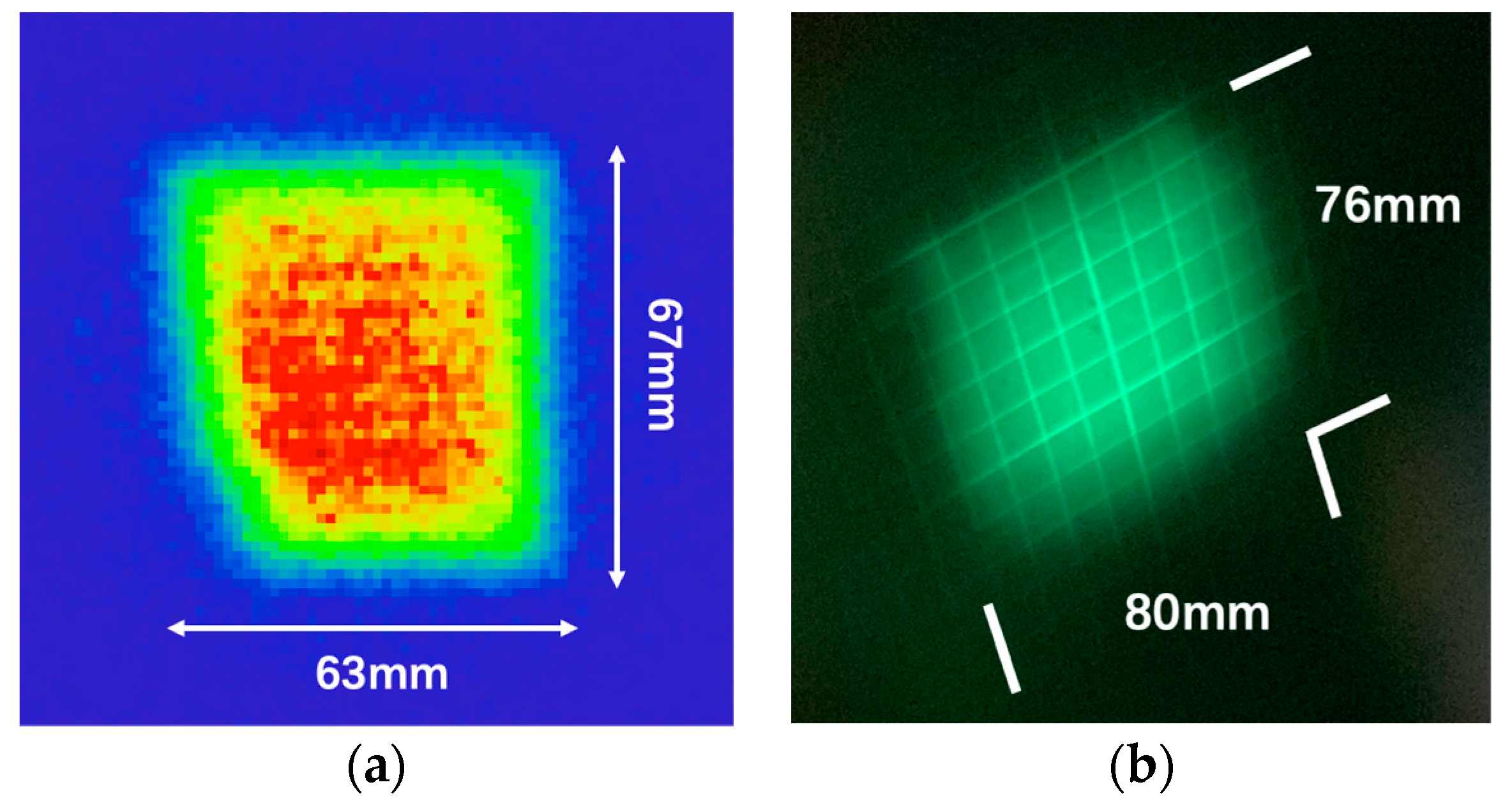

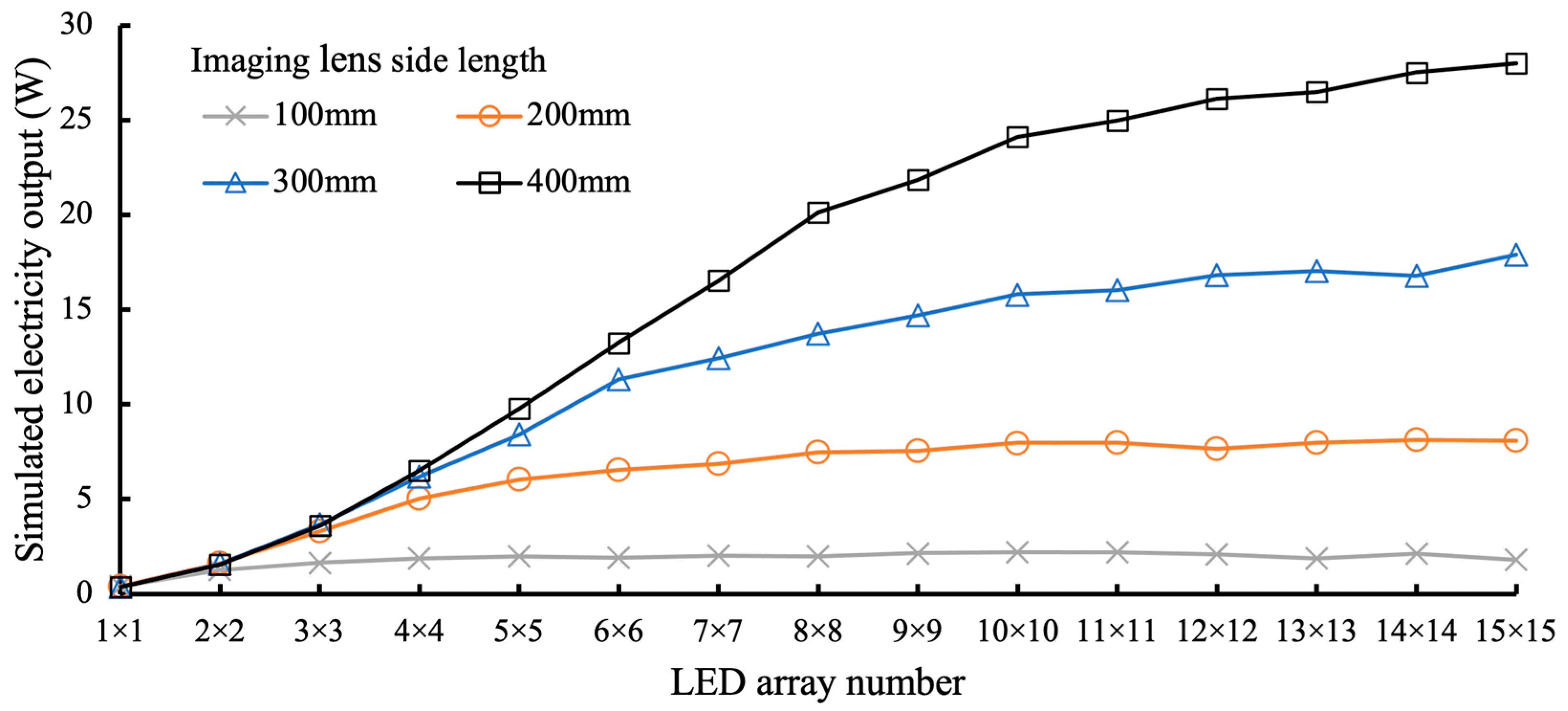
| r | 10 mm | 15 mm | 20 mm | 25 mm | 30 mm | 35 mm | 40 mm | 45 mm | 50 mm | |
|---|---|---|---|---|---|---|---|---|---|---|
| f | ||||||||||
| 5 mm | 49 | 53 | 54 | 55 | 53 | 48 | 42 | 35 | 28 | |
| 10 mm | 133 | 176 | 193 | 200 | 196 | 182 | 158 | 131 | 109 | |
| 15 mm | n/a | 305 | 357 | 390 | 395 | 371 | 324 | 273 | 227 | |
| Lens System Efficiency | Irradiation Spot (mm2) | Surface Irradiation (W) | Electricity Output (W) | |
|---|---|---|---|---|
| sim. | 39.7% | 63 × 67 | 3.98 | n/a |
| exp. | 34.8% | 76 × 80 | 2.65 | 1.04 |
Publisher’s Note: MDPI stays neutral with regard to jurisdictional claims in published maps and institutional affiliations. |
© 2022 by the authors. Licensee MDPI, Basel, Switzerland. This article is an open access article distributed under the terms and conditions of the Creative Commons Attribution (CC BY) license (https://creativecommons.org/licenses/by/4.0/).
Share and Cite
Zhao, M.; Miyamoto, T. 1 W High Performance LED-Array Based Optical Wireless Power Transmission System for IoT Terminals. Photonics 2022, 9, 576. https://doi.org/10.3390/photonics9080576
Zhao M, Miyamoto T. 1 W High Performance LED-Array Based Optical Wireless Power Transmission System for IoT Terminals. Photonics. 2022; 9(8):576. https://doi.org/10.3390/photonics9080576
Chicago/Turabian StyleZhao, Mingzhi, and Tomoyuki Miyamoto. 2022. "1 W High Performance LED-Array Based Optical Wireless Power Transmission System for IoT Terminals" Photonics 9, no. 8: 576. https://doi.org/10.3390/photonics9080576
APA StyleZhao, M., & Miyamoto, T. (2022). 1 W High Performance LED-Array Based Optical Wireless Power Transmission System for IoT Terminals. Photonics, 9(8), 576. https://doi.org/10.3390/photonics9080576





